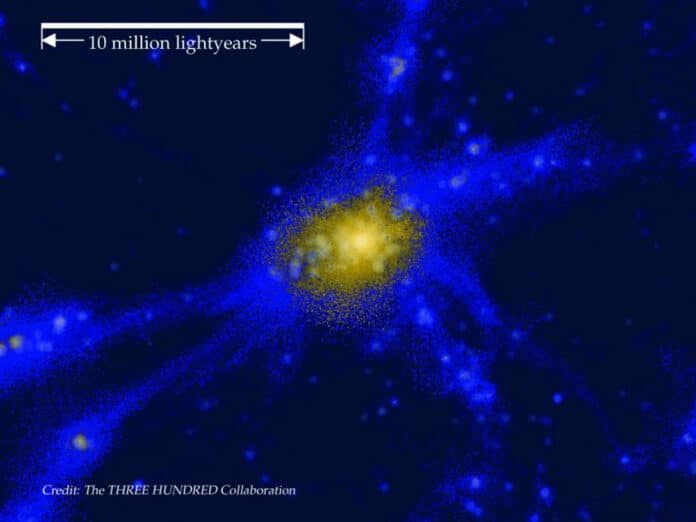Surrounding a newly discovered galaxy protocluster is a gas that’s hotter than expected.
The first bubble in the intergalactic stew.
Astrophysicists have used the W. M. Keck Observatory in Hawaii to discover a galaxy protocluster called COSTCO-I in the early universe, which is surrounded by unexpectedly hot gas. During this time, the intergalactic medium, which filled most of the space outside of visible galaxies, was much cooler than it is now. However, COSTCO-I, which dates back to a time 11 billion years ago, is shrouded by gas that displays the characteristics of the modern-day intergalactic medium, known as the “Warm-Hot Intergalactic Medium” (WHIM), that has temperatures ranging from 100,000 to over 10 million degrees Celsius.
This discovery is remarkable because it identifies a patch of ancient gas that has reached the temperature of the WHIM, making it the earliest known part of the universe to do so. The Cosmic Noon, when galaxies were at the peak of star formation, was filled with cold gas, with temperatures of around 10,000 degrees Celsius, providing galaxies with the ideal environment to form and thrive.

Astrophysicists have made a groundbreaking discovery using the W. M. Keck Observatory on Maunakea in Hawaiʻi, having identified a galaxy protocluster in the early universe called COSTCO-I. This protocluster is surrounded by gas that is surprisingly hot, which is significant as it is the first instance in which ancient gas has been identified that shows characteristics of the modern-day intergalactic medium. The intergalactic medium of today, which is referred to as the “Warm-Hot Intergalactic Medium” (WHIM), has temperatures ranging from 100,000 to over 10 million degrees Celsius, whereas during the time of the early universe, intergalactic medium was cooler.
According to Khee-Gan Lee, an assistant professor at Kavli IPMU and co-author of the paper, COSTCO-I was the first bubble astronomers observed, during an era in the distant past when most of the pot was still cold. When examining the ultraviolet spectra encompassing the COSTCO-I region, the team noticed that the protocluster did not display the common hydrogen absorption signal typically associated with galaxy protoclusters. This finding is significant because it will help reveal the mechanisms that caused the intergalactic gas to boil up into the present-day WHIM.
Journal Reference:
Chenze Dong et al. Observational Evidence for Large-scale Gas Heating in a Galaxy Protocluster at z = 2.30. The Astrophysical Journal Letters. DOI: 10.3847/2041-8213/acba89
Do not forget to share your opinion with us to provide you with the best posts !



If you wish for to improve your know-how only keep visiting this site and be updated with the most up-to-date news update posted here.
There is definately a great deal to know about
this topic. I really like all of the points
you’ve made.
Awesome post.